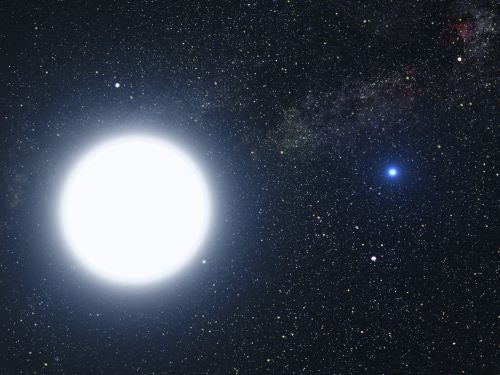Q: When Sirius A expands into a red giant, could white dwarf Sirius B go supernova by pulling gas from Sirius A’s outer layers and produce heavy elements via the r-process?
A: The answer is perhaps, but unlikely. The key uncertainties are the speed at which mass is lost from the giant Sirius A, whether the material that lands on the white dwarf explodes on contact, and whether enough mass can be collected by the white dwarf to get close to the Chandrasekhar limit.
Sirius A and B are quite widely separated, by about 25 times the distance between Earth and the Sun. The larger Sirius A is about twice the mass of the Sun and its white dwarf companion is about the same mass as the Sun. As stellar winds blow material off the surface of Sirius A, some mass can be gravitationally captured by the white dwarf.
The effectiveness of this capture is strongly related to the wind speed. As a main sequence star, Sirius A currently loses little mass, which escapes at high speeds, so Sirius B cannot easily capture it. However, when Sirius A draws toward the end of its life, it will swell to become an asymptotic giant branch (AGB) star. These huge red giants have radii as big as the Earth-Sun separation, but still much smaller than the separation between Sirius A and B. AGB stars blow away a lot of their mass — perhaps 75 percent — in the form of a dusty, slow-moving wind, and this can be partially captured by the white dwarf.
In order to explode as a supernova, the white dwarf must increase its mass to close to 1.4 times the mass of the Sun, known as the Chandrasekhar limit. It seems unlikely that it will be able to do this unless the wind from the AGB star is even slower than expected, especially as the orbit of the two stars will widen as mass escapes from the system as a whole. Even if the white dwarf were to capture this much mass, it may not necessarily stick! The hydrogen-rich material from the giant star can periodically ignite on the white dwarf’s surface, causing a more modest explosion, called a nova, which would blow the material back into space and might even reduce the mass of the white dwarf.
So, in summary, in about 500 million years Sirius A will expand dramatically and lose nearly three-quarters of its mass in the form of a slow, dusty wind. A fraction of this will be captured by the white dwarf, but in order to explode as a supernova, it must first accrete enough mass to get close to the Chandrasekhar limit, and, second, must avoid explosively igniting the accreted material prematurely. Based on our current understanding, neither of those two conditions looks likely.
The final part of your question asks about r-process elements. These are elements that are built up by a series of “rapid” neutron captures followed by radioactive decay. Examples of these are precious metals like gold and platinum. There are two probable sites in the universe where r-process elements are made: colliding neutron stars and core-collapse supernovae of massive stars. The supernova caused by the detonation of a white dwarf is quite different. It consists of the explosive ignition of carbon and oxygen, and there is no rich source of neutrons to make r-process elements. So, the elements produced in a white dwarf supernova (known as a type Ia supernova) are mostly the products of oxygen and carbon fusion, like silicon, sulfur, iron, and nickel.










